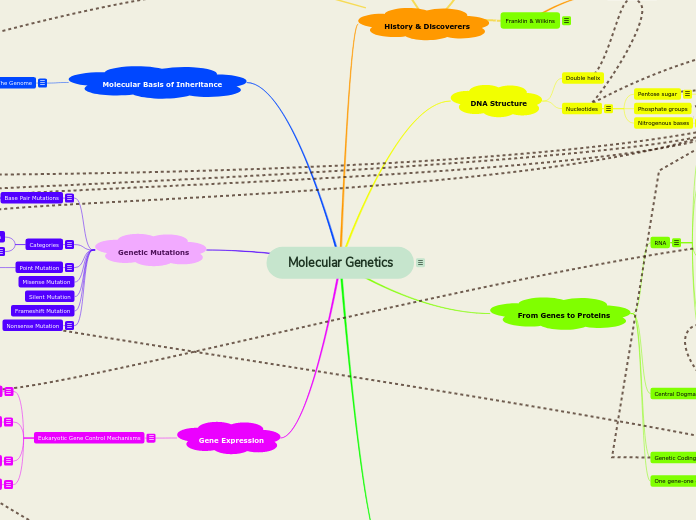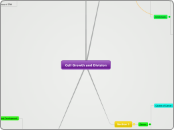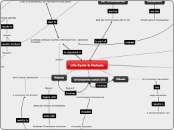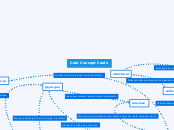Franklin & Wilkins
CONNECTION TO WATSON & CRICK: Wilkins revealed the details of Franklin’s work to James Watson and Francis Crick - two scientists who built a model of the DNA molecule.
Watson & Crick
CONNECTION TO NUCLEOTIDES: Watson and Crick's DNA model initially incorporated their knowledge on the nucleotides that make up DNA.
CONNECTION TO DOUBLE HELIX: After Franklin's ideas about DNA's double helix were shared with Watson and Crick, their model was modified to incorporate this fact.
Frederick Griffith
CONNECTION TO AVERY, MACLEOD, & MCCARTY: Griffith set the foundation for the findings of these three coworkers, in which they built on his discovery of the transforming principle to confirm DNA transformation.
Avery, MacLeod, & McCarty
Friedrich Meischer
Gregor Mendel
Molecular Genetics
FOCUS QUESTION: How did the study of molecular genetics contribute to an enhanced comprehension of the structure and function of eukaryotic DNA, as well as its differentiation from RNA and genetic material that has been mutated?
Gene Expression
Eukaryotic Gene Control Mechanisms
CONNECTIONS TO TRANSCRIPTIONAL, TRANSLATIONAL, POST-TRANSCRIPTIONAL, POST-TRANSLATIONAL: Eukaryotic control mechanisms fall into these four categories.
Post-transcriptional
CONNECTION TO ALTERNATIVE SPLICING: An example of this type of eukaryotic regulation is alternative splicing.
Transcriptional
CONNECTION TO CHROMATIN REMODELLING COMPLEX AND METHYLATION: These are two types of transcriptional regulation.
Methylation
Chromatin Remodelling Complex
Post-translational
CONNECTION TO PROCESSING, CHEMICAL MODIFICATION, AND DEGRADATION: These three methods are used to regulate expression by limiting the availability of functional proteins after mRNA has been translated and proteins are synthesized.
Degradation
Chemical modification
Processing
Translational
CONNECTION TO POLY(A) TAIL: In this type of eukaryotic regulation, there is a change in the length of the poly(A) tail.
Genetic Mutations
Nonsense Mutation
CONNECTION TO STOP CODON: A premature stop codon can be the result of a nonsense mutation.
Frameshift Mutation
Silent Mutation
Misense Mutation
Point Mutation
CONNECTION TO SNP: A change in a single nucleotide within a gene can cause a difference in the DNA between individuals, known as an Single Nucleotide Polymorphism (SNP).
Single Nucleotide Polymorphism (SNP)
Categories
CONNECTION TO SPONTANEOUS MUTATION: This is one category of mutations, in which there is an error in DNA replication.
CONNECTION TO INDUCED MUTATION: This is another category of mutations that are caused by an environmental agent.
Induced Mutation
CONNECTION TO MUTAGEN: A mutagen is the specific environmental agent that causes induced mutations.
Mutagen
Spontaneous Mutation
Base Pair Mutations
CONNECTION TO INSERTION, DELETION, SUBSTITUTION, AND INVERSION: These are the types of base pair mutations.
Inversion
CONNECTION TO A, T, G, C: Inversion occurs when two adjacent bases trade places or when the sequence of DNA is reversed.
Substitution
CONNECTION TO A, T, G, C: Substitution is the replacement of one base pair in a DNA sequence by another base pair.
Deletion
CONNECTION TO A, T, G, C: Deletion is the removal of a base pair or larger coding region from a DNA sequence.
Insertion
CONNECTION TO A, T, G, C: Insertion is the addition of a base pair or larger coding region to a DNA sequence.
Molecular Basis of Inheritance
The Genome
CONNECTION TO CHROMOSOMES: The genome is spread over many chromosomes.
Chromosomes
CONNECTION TO DNA: Chromosomes are formed from tightly coiled and compacted DNA.
DNA (Deoxyribonucleic Acid)
CONNECTION TO GREGOR MENDEL: Gregor Mendel was the first to understand DNA as the hereditary molecule.
DNA Replication
Semiconservative Replication
CONNECTION TO STRAND SEPARATION: Strand separation is the first step of the semiconservative replication of DNA
CONNECTION TO BUILDING COMPLEMENTARY STRANDS: Building complementary strands is the second step of the semiconservative replication of DNA.
CONNECTION TO DEALING WITH ERRORS: Dealing with errors is the third and final step of the semiconservative replication of DNA.
Dealing with Errors
Building Complementary Strands
Strand Separation
CONNECTION TO HELICASE: This replication enzyme initiates the separation of the parent DNA strands.
CONNECTION TO TOPOISOMERASES: These class of enzymes work to relieve tension caused by the unwinding of parent DNA during strand separation.
CONNECTION TO SSBs: These replication enzymes prevent annealing by attaching to the parent DNA strands.
CONNECTION TO RNA PRIMASE: This replication enzyme produces a primer that acts as a starting point for replication, while strand separation continues to take place.
RNA primase
CONNECTION TO RNA PRIMER: RNA primase lays down RNA primer as the replication fork continues to open and the parent DNA strands separate.
RNA Primer
CONNECTION TO DNA POLYMERASES: With RNA primer now in place, these group of enzymes (specifically DNA polymerase III) begins adding new DNA nucleotides to the RNA primer.
DNA polymerases
CONNECTION TO I, II, III: There are three types of DNA polymerase: DNA polymerase I, DNA polymerase II, and DNA polymerase III.
CONNECTION TO BUILDING COMPLEMENTARY STRANDS AND DEALING WITH ERRORS: In general, DNA polymerases (I, II, III) have two main functions: to assemble nucleotides into new DNA strands and to proofread and repair replication errors and other damage to DNA molecules.
CONNECTION TO NUCLEOTIDES: One of the major functions of DNA polymerases is to synthesize DNA from deoxyribonucleotides.
I, II, III
Single-strand binding proteins (SSBs)
Topoisomerases
Helicase
From Genes to Proteins
One gene-one enzyme hypothesis
CONNECTION TO ONE GENE-ONE POLYPEPTIDE HYPOTHESIS: The one gene-one enzyme hypothesis was later restated as the one gene-one polypeptide hypothesis.
One gene-one polypeptide hypothesis
Genetic Coding
CONNECTION TO CODON: A codon is a group of three base pairs that code for an individual amino acid; they provide a mechanism for genetic coding.
Codon
CONNECTION TO START CODON: A specific codon that begins translation.
CONNECTION TO STOP CODON: A specific codon that terminates translation.
Stop Codon
Start Codon
Central Dogma
CONNECTION TO TRANSCRIPTION AND TRANSLATION: The central dogma is the fundamental principle that states that genetic information flows from DNA to RNA (transcription) to proteins (TRANSLATION).
Translation
CONNECTION TO INITIATION: This is the first major stage of translation.
CONNECTION TO ELONGATION: This is the second major stage of translation.
CONNECTION TO TERMINATION: This is the third major stage of translation.
CONNECTION TO STOP CODON: This is the codon that signals the end of the polypeptide chain and causes the ribosome to terminate translation.
CONNECTION TO START CODON: This is the codon that signals the start of the polypeptide chain and initiates translation.
Transcription
CONNECTION TO INITIATION: This is the first step of transcription.
CONNECTION TO ELONGATION: This is the second step of transcription.
CONNECTION TO TERMINATION: This is the third step of transcription.
Termination
CONNECTION TO TERMINATION SEQUENCE: When RNA polymerase recognizes the termination sequence, termination occurs.
Termination Sequence
Elongation
Initiation
CONNECTION TO PROMOTER: Initiation occurs at the promoter.
Promoter
CONNECTION TO TATA BOX: This is a region of the promoter.
TATA Box
CONNECTION TO RNA POLYMERASE: The TATA box enables the binding of RNA polymerase.
RNA polymerase
CONNECTION TO BUILDING COMPLEMENTARY STRANDS: Once RNA polymerase binds to the promoter and opens the DNA double helix, it begins building a complementary single-stranded RNA molecule.
CONNECTION TO TERMINATION SEQUENCE: RNA polymerase detects the termination sequence to stop transcription.
Building complementary strands
CONNECTION TO BUILDING A COMPLEMENTARY STRAND IN DNA REPLICATION: In both processes (DNA replication and protein synthesis), complementary strands are built using a DNA template strand.
RNA
CONNECTION TO SINGLE-STRANDED AND NUCLEOTIDES: RNA is a single-stranded molecule that incorporates nucleotides.
CONNECTION TO mRNA, tRNA, and rRNA: These are the different types of RNA.
rRNA
CONNECTION TO RIBOSOMES: rRNA makes up ribosomes.
Riboosomes
CONNECTION TO TRANSLATION: Ribosomes carry out protein synthesis by translating mRNA into chains of amino acids.
tRNA
CONNECTION TO ANTICODON: Each tRNA contains a set of three nucleotides called an anticodon.
CONNECTION TO TRANSLATION: tRNA is required during translation by the ribosome to assemble one amino acid at a time into a polypeptide chain.
Anticodons
CONNECTION TO CODONS: Anticodons, located in tRNA, correspond to their complementary codons in mRNA during translation.
mRNA
CONNECTION TO PRECURSOR mRNA: This is the eukaryotic mRNA that is made initially during transcription. It cannot exit the nucleus until it has been modified.
CONNECTION TO MODIFIED mRNA: This is the eukaryotic mRNA that has underwent modifications and can now exit the nucleus to reach the ribosome.
Modified mRNA
CONNECTION TO POLY(A) TAIL: This is one modification that is made to the mRNA, in which a chain of 50 to 250 adenine nucleotides are added to the 3' end.
CONNECTION TO 5' CAP: This is another modification that is made to the mRNA, in which a sequence of seven Gs are added to the start of the precursor mRNA.
CONNECTION TO mRNA SPLICING: This is the final modification that is made to the mRNA, in which introns are signalled for removal.
mRNA splicing
CONNECTION TO SPLICEOSOME: mRNA splicing is a modification made to precursor mRNA, in which introns are removed in an enzyme-protein complex called a spiceosome.
CONNECTION TO ALTERNATIVE SPLICING: Introns are signalled for removal by a handful of snRNPs that bind to them.
CONNECTION TO ALTERNATIVE SPLICING: This subjects the precursor mRNA to alternative splicing, in which many mRNAs are produced from a single precursor molecule. Thus, more than one polypeptide can be made from a single gene.
CONNECTION TO INTRONS: mRNA splicing removes introns from precursor mRNA.
Small ribonucleoprotein (snRNPs)
Spliceosome
Alternative splicing
5' cap
Poly(A) tail
Precursor mRNA
CONNECTION TO INTRONS AND EXONS: Precursor mRNA consists of both introns (non-coding sequences) and exons (coding sequences).
Exons
Introns
CONNECTION TO PENTOSE SUGAR, NITROGENOUS BASES, AND PHOSPHATE GROUPS: RNA nucleotides consist of these three parts!
CONNECTION TO DNA NUCLEOTIDES' PHOSPHATE GROUPS: Both DNA and RNA nucleotides consist of phosphate groups.
CONNECTION TO A, U, G, C: RNA nucleotides incorporate nitrogenous bases called Adenine, Guanine, Uracil, and Cytosine, which form complementary base pairs with one another (U forms hydrogen bonds with A, C forms hydrogen bonds with G).
CONNECTION TO DNA NITROGENOUS BASES: Although base pairs slightly differ, both DNA and RNA nucleotides consist of nitrogenous bases.
A, U, G, C
CONNECTION TO GENETIC CODING: A, U, G, C makes up the RNA alphabet in regards to genetic coding.
CONNECTION TO RIBOSE: RNA nucleotides incoporate pentose sugars called ribose.
CONNECTION TO DNA NUCLEOTIDE PENTOSE: Both DNA and RNA nucleotides incorporate pentose sugars (although their pentose sugars differ).
Ribose
Single-stranded
DNA Structure
Nucleotides
CONNECTION TO PENTOSE SUGAR, PHOSPHATE GROUPS, AND NITROGENOUS BASES: DNA nucleotides consist of these three parts!
Nitrogenous bases
CONNECTION TO A, T, G, C: DNA nucleotides incorporate nitrogenous bases called Adenine, Guanine, Thymine, and Cytosine, which form complementary base pairs with one another at the centre of the helix (A forms hydrogen bonds with T, C forms hydrogen bonds with G)
A, T, G, C
CONNECTION TO GENETIC CODING: A, T, G, C make up the DNA alphabet in regards to genetic coding!
Phosphate groups
Pentose sugar
CONNECTION TO DEOXYRIBOSE: DNA nucleotides incoporate pentose sugars called deoxyribose.
Deoxyribose
Double helix
History & Discoverers









